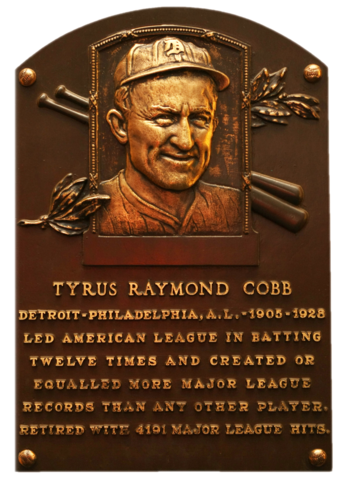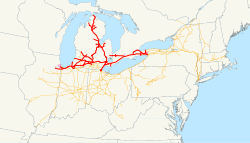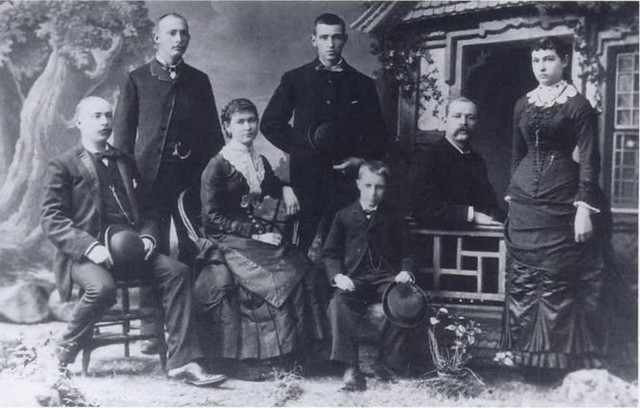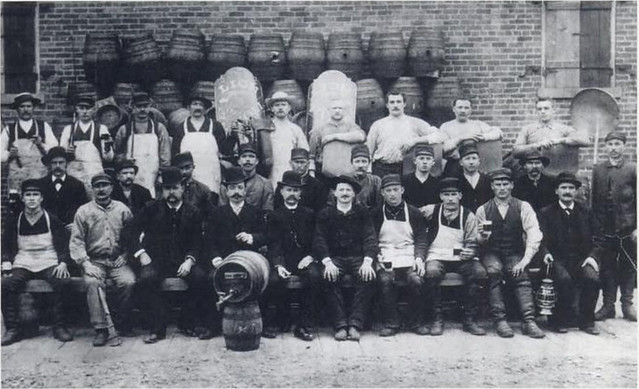
On February 2, 1936, Ty Cobb becomes one of the first players selected to enter the newly formed Baseball Hall of Fame.
Sources :
Michigan History Magazine
Tyrus Raymond Cobb Inducted to the Hall of Fame in: 1936, and by the way he received the most votes out of the first five inducted.
:max_bytes(150000):strip_icc():format(webp)/cdn.cliqueinc.com__cache__posts__187298__christie-brinkley-reveals-the-secret-to-her-ageless-skin-and-hair-1699628-1458196354.700x0c-0ee7c440f5d24a03a5ff422ae2ccdf71.jpg)
Believe it or not, but Christie Brinkley was born Christine Lee Hudson in Monroe, Michigan on February 2, 1954, although she moved to California with her family as a child.
Brinkley gained worldwide fame beginning in the late 1970s with three consecutive Sports Illustrated Swimsuit Issue covers through 1981. She spent twenty-five years as the face of CoverGirl (the longest running cosmetics contract of any model in history), has appeared on over 500 magazine covers, and has signed contracts with major brands—both fashion and non-fashion.
Brinkley went on to work as an actress, illustrator, television personality, photographer, writer, designer, and activist for human and animal rights and the environment.
Brinkley has been married four times, most notably to musician Billy Joel, several of whose music videos she appeared in. Her fourth marriage, to architect Peter Cook, ended in a much-publicized 2008 divorce.
With a career spanning more than three decades, magazines such as Allure and Men’s Health have named Brinkley one of the most attractive women of all time. Her financial holdings in 2018 were worth an estimated US$250 million, primarily as the owner of several companies and real estate.
Source : Christie Brinkley wikipedia entry.
Doc Emrick takes a look back on the first outdoor game ever played by an NHL team, which was on Feb. 2, 1954 when the Detroit Red Wings played the inmates of Marquette Branch Prison in the recreation yard.
On February 2, 1954, the Red Wings were invited by Emery Jacques, the Marquette prison’s last politically appointed warden, to play an outdoor game – the first in franchise history – inside the razor wire-topped stone walls and armed watchtowers of the state’s most notorious maximum-security prison, the Alcatraz of the North.
Marquette’s inmate population comprised the worst of the worst, and their hockey skills weren’t much better, so some tried to build up the game by emphasizing the convicts’ crimes and the possibility of a real brawl when the Marquette Prison Pirates linedup against the Wings.
Wings legend Ted Lindsay wasn’t the least bit concerned about a prison yard fracas, saying, “I was viewed as a hero because I was leading the league in penalties, so I fit right in with the boys.”
The playing conditions in Marquette that day were perfect, prompting Gordie Howe to say that the ice was “the best he had ever played on.”
Lindsay agreed, saying, “Anytime you get nature doing the freezing you’ve got the best ice possible.”
But someone had to build the rink of dreams, and that was Oakie Brumm. The prison’s director of physical activity and a former University of Michigan hockey player, Brumm was tasked with creating a rink in the prison yard without the convicts using the materials as tools for escaping.
Brumm would later write about his experiences in the prison in a book entitled “We Only Played Home Games” where he recounted his memories, including the only time an NHL club played inside a penitentiary.
“The inmates and I saw all of this as a future hockey rink,” wrote Brumm, who died in 2006. “Most of the custodial staff considered this serious escape equipment, at least until it was nailed down.”
The game on prison ice was the greatest thrill most of the inmates and staff had ever experienced. Wings coach Tommy Ivan put his team through a series of big league drills and skills competitions, and then the Wings defeated the Pirates soundly by displaying some of the dazzling stick work that made them league champions for seven consecutive seasons.
“They were more curious because they had heard us on the radio and seen us on the television,” said Lindsay, of the inmates. “Now they were looking at the real person.”
To make things interesting, the Wings swapped a few players, trading goalie Terry Sawchuk, among others, and exchanged one set of defensemen, said Lindsay, who skated on the opposite wing as Howe with an inmate as their centerman.
Howe then skated the second half of the game with the prison’s wear a No. 16 Pirates’ jersey.
Believe it or not, but the Red Wings ran away with the game and the warden presented Wings General Manager Jack Adams with a honey bucket as a makeshift trophy. Lindsay doesn’t remember the final score, which he calls insignificant.
History was made on that day, history that no other NHL team has ever duplicated. The first Winter Classic of 1954.
For the full article, see Bill Roose, Wings’ first outdoor game was in prison; First ‘Winter Classic’ was 58 years ago in Michigan prison”, RedWings.com, February 9, 2012.
Recalling Red Wings vs. Prisoners.
For another, see Richard Bak, “Red Wings’ 1954 Prison Game Featured Pros and Cons“, Detroit Athletic Company, January 25, 2015.
Christopher Klein, “You Won’t Believe Where the First NHL Outdoor Game Was Played“, History.com, December 28, 2016.
Also see We only played home games : wacky, raunchy, humorous stories of sports and other events in Michigan’s maximum security prison / by Leonard “Oakie” Brumm. Oak Creek, Wis. : Brumm Enterprises, c2001. 228pp. MSU Library HV8860 .B78 2001b

In what the National Weather Service called “a top 10 storm” for Michigan, Groundhog Day blizzard conditions brought about a foot of snow to mid-Michigan, along with high winds and frigid temperatures, creating dangerous wind chills and hazardous travel conditions. As a result, MSU suspended classes on February 2, 2011. However the university’s critical functions were maintained and dining halls remained open, while electronic services and business operations were supported remotely. Classes and normal operations resumed February 3.
The university had only closed or canceled classes four other times:
• January 26-27, 1967: After a snowfall of 26 inches, the university closed for the first time in its history.
• April 3, 1975: A freak snowstorm dumped 15 inches of wet snow that came down so quickly, roads and walks were impassable. As this was in April, many people weren’t prepared to deal with snow. The snowfall subsequently led to one of the biggest floods in mid-Michigan history two weeks later.
• January 26-27, 1978: A 24-inch snowfall closed the university for two days.
• January 19, 1994: Classes were suspended due to cold weather (18 degrees below zero; wind chill, 51 degrees below zero), the second coldest temperature recorded this century. The university remained open.
Source : “MSU suspends classes for only 5th time due to weather“, MSU Today, February 3, 2011
Addendum : Top Six MSU Closures Due to Snow, Cold, or a Combination
Number 1. The first time the campus was closed was on January 27, 1967, when 26 inches of snow fell on campus.
Number 2. A freak snowstorm on April 3, 1975 dumped 15 inches of wet snow, making roads and sidewalks impassable. Many people weren’t prepared for that kind of weather so late in the spring. It later led to one of the biggest floods in mid-Michigan history about 2 weeks later.
Number 3. The blizzard of ’78 also forced the university to suspend classes, after 24 inches of snow closed MSU for 2 days on January 26 & 27.
Number 4. Cold weather was the reason why MSU suspended classes on January 19, 1994. Temperatures were 18 degrees below zero, with a wind chill of 51 degrees below zero, the second coldest temperature recorded this century. While classes were suspended, the university stayed open.
Number 5. On February 2, 2011, classes were suspended for blizzard conditions that brought nearly a foot of snow, high winds and frigid temperatures. University critical functions were maintained, while electronic services and business operations were done remotely. The National Weather Service called this a “top 10 storm” for Michigan.
Number 6. January 6-7, 2014. After nearly two days of suspended operations, classes at MSU are expected to resume at 5pm Tuesday, marking the sixth time in university history it had to close to due to weather.
Sources:
“Recent MSU Closure Marks 6th Time in University History“, WILX News, Channel 10, January 7, 2014.
Eve Adoulos and Hillary Gatlin, “A History of Snow Days at MSU”, Tales from the Archives: Volume One, Campus and Traditions, 1917.
Oakland University’s Travis Bader set the NCAA Division I record for the most career 3-pointers on Sunday against Milwaukee, surpassing the previous mark of 457 set by Duke’s J.J. Redick.
Bader, who entered the game two behind Redick, missed his first 3-point attempt but made his next four. He broke the record with a shot from the right corner with 6:17 left in the first half, pulling Oakland within 29-28.
Travis Bader sets 3-pointers record, ESPN, February 2, 2014.
For the sixth time in its history, MSU suspended classes — at least for the morning – because of a heavy snowfall. The Lansing area got between 10 and 12 inches of snow in Sunday’s storm.
In a related note the University of Michigan also suspended classes for the second time in 37 years.
On February 3, 1838, passengers rode the Michigan Central Railroad for the first time, from Detroit to Ypsilanti. Eventually, it would expand to connect many more exotic places like Niagara Falls!
 Michigan Central Railroad (red) and New York Central system (orange) as of 1918
Michigan Central Railroad (red) and New York Central system (orange) as of 1918
Michigan Central Railroad (Battle Creek Depot Station) opened on July 27, 1888.
Sources :
Detroit Historical Society Facebook Page
Michigan Central Railroad wikipedia entry
Michigan Central Railroad : History of the Main Line 1846-1901 available through MelCat and Interlibrary Loan : In pioneer America, the Michigan Central Railroad (MCRR) became the major route between east and west, linking older states and their restless populations to young cities like Detroit and Chicago, and to the wide open spaces beyond. Now, for the first time in book form, historian Nick Marsh systematically relates the colorful story of this legendary enterprise, drawing on numerous archival records, photographs, and artifacts. The MCRR story is a story of toil, triumph, and tragedy. Marsh includes chapters on the railroad’s construction, its conversion from a state-owned to a private enterprise, the sad ending to a Michigan farmers’ rebellion, the involvement of William H. Vanderbilt, and the empire building of the visionary James F. Joy. Eagerly anticipated by many, the appearance of Marsh’s comprehensive account will bring joy to legions of rail fans, history buffs, and connoisseurs of Americana.
Railroads for Michigan / Graydon M. Meints.
Bill Loomis, “Riding the first rails brought excitement, danger”, Detroit News, July 8, 2012.
Today is the birthday of Julius Stroh (February 3, 1856-June 2, 1939). He was born in Michigan, the son of Bernard Stroh, who founded the Stroh Brewery in Detroit, Michigan in 1850. After his father died, his brother Bernard Jr. took over the brewery, but in 1908 he assumed control of the family brewery.

Julius Stroh in 1933, pouring the first glass of beer after Michigan repealed prohibition.
Given the time he was at the helm of the Stroh Brewery, there’s surprisingly little biographical information or images of him.

The Stroh family around 1871, with Julius on the far left.
This is what Wikipedia has to say about Stroh’s early days through Julius Stroh’s tenure:
The Stroh family began brewing beer in a family-owned inn during the 18th century in Kirn, Germany. In 1849, during the German Revolution, Bernhard Stroh (1822-1882), who had learned the brewing trade from his father, emigrated to the United States. Bernhard Stroh established his brewery in Detroit in 1850 when he was 28 and immediately started producing Bohemian-style pilsner, which had been developed at the municipal brewery of Pilsen, Bohemia in 1842. In 1865, he purchased additional land and expanded his business and adopted the heraldic lion emblem from the Kyrburg Castle in Germany and named his operation the Lion’s Head Brewery. (The lion emblem is still visible in its advertising and product labels.)
Bernhard Stroh’s original beer selling operation consisted of a basement brewing operation and was then sold door-to-door in a wheelbarrow. The new beer (Stroh’s) sold door-to-door was a lighter-lager beer, brewed in copper kettles.
The Stroh Brewery around 1864.Bernhard Stroh Jr. took charge of the brewery on the death of his father. He changed the brewery’s name to the B. Stroh Brewing Company. With the introduction of pasteurization and refrigerated rail cars, Stroh was able to ship some of his beer as far as Florida and Massachusetts. In 1893 Stroh Bohemian Beer won a blue ribbon at the Columbian Exposition in Chicago. The company’s name was changed to The Stroh Brewery Company in 1902. In 1908, Bernhard Stroh’s brother Julius Stroh took over the brewery. After a tour of famous European breweries, he introduced the European fire-brewing method in the Stroh brewery. Common in Europe before World War I, the fire-brewing process uses a direct flame rather than steam to heat beer-filled copper kettles. The company claims that the resulting higher temperatures bring out more of the beer’s flavor.
During Prohibition, Julius Stroh operated the business under the name The Stroh Products Company, producing near beer (beer with its alcohol extracted), birch beer, soft drinks, malt products, ice cream, and ice. Though production of most of these items ceased when Prohibition ended in 1933, a special unit of the brewery continued to make Stroh’s Ice Cream (this facility remained in Detroit until February 2007, when the operation was moved to Belvidere, Illinois, though the distribution facility in Detroit still remains).
Upon Julius Stroh’s death in 1939, his son Gari Stroh assumed the presidency.

Stroh employees around 1885, with Julius Stroh sitting behind the barrel.
Sources:
Jay Brooks, “Historic Beer Birthday: Julius Stroh“, Brookston Beer Bulletin, February 3, 2018.
Brewed in Detroit: Breweries and Beers Since 1830, Volume 1. Peter Blum. Detroit : Wayne State University Press, [1999]
On February 3, 1889, the ten-story Hammond Building became Detroit’s first skyscraper. Located at West Fort and Griswold Streets, the building was demolished in 1956 and replaced by the new headquarters for the National Bank of Detroit, which is now known as The Qube.
When the Hammond opened, “Detroit was astir with excitement over the completion of its first skyscraper,” William Hawkins Ferry wrote. To celebrate, tightrope walker Tommy Davenport was hired to walk across Fort Street, a dizzying 10 stories up.
“I remember when the Hammond Building was the eighth wonder of the world as a skyscraper and a tight-rope walker walked from the City Hall tower to the new Hammond Building. Our tonsils were sunburnt for days after,” Detroit News editor Malcolm W. Bingay wrote in 1935.
On Aug. 31, 1890, the Free Press reported that every window of the Hammond was illuminated, creating a “pillar of light” and a “splendid sight” for throngs of onlookers, both common Detroiters and visitors to that year’s Detroit International Exposition. “The 246 offices and the stores on the ground floor have been brightly lighted up with Edison incandescent lights and gas every night during the past week to give exposition visitors an opportunity of viewing the magnitude of the building after dark,” the Free Press wrote. The building was open during the day and evening to allow Expo visitors to climb to the top for “a splendid bird’s-eye view of the city.”
Detroiters “clamored for an opportunity to climb to the roof and look over the sprawling city,” the Free Press wrote in 1938. “Up-state communities, arranging for excursions to this metropolis, began to advertise the unprecedented opportunities for a bird’s-eye view of Detroit from the roof of the Hammond Building.” Such excitement, festivities and awe made the Hammond a beloved landmark to Detroiters for decades.
The Hammond’s height led to it becoming the headquarters of the local weather bureau. Captains of freighters headed up the Detroit River would look to the Hammond’s roof, where flags during the day and oil lanterns by night signaled storm conditions on the Great Lakes. The building’s main floor was used for stores and bank offices, and the rest was office space, which housed some of Detroit’s most influential movers and shakers, from the Joys to the Newberrys to the McMillans. The Detroit Tigers had an office in the Hammond, and fans would look up to its roof to see whether a white flag with a blue circle was flying: That was the signal that the Tigers were playing that day at Bennett Park, which was located on the site of Tiger Stadium before the beloved ballpark was constructed.
Sources:
Michigan Historical Society Page (February 3 entry)
Dan Austin, Hammond Building, HistoricDetroit.org
Sydney Harris Howe, no relation to Gordie, joined the Wings in 1935, bought along with another player named Scotty Bowman (no relation to the game’s winningest coach) for $50,000 in a deal that completely surprised Howe.
Howe was one of the league’s leading scorers for a decade. On Feb. 3, 1944, he scored a record 6 goals in one game. The next day The Detroit News detailed the goals, and the wildly happy crowd’s antics. The large crowd of 12,293 — which included 900 school patrol boys — became more frenzied as the double hat trick became more inevitable.
The crowd groaned as Howe shot the puck over the net early in the third period but half a minute later Mud Bruneteau and Grosso set him up again. Howe feinted McAuley. As the latter lunged to the right, Howe flicked the puck right over McAuley into the net.” A grinning Howe left the game on the shoulders of his teammates, to the ecstatic cheers of the spectators.
“They were going in the net tonight — another night they don’t,” Howe said modestly. “I don’t remember any goal in particular. The boys were feeding them to me nicely.
“No celebration for me,” he added, “I’m due at work at 7:10 a.m.”
Howe worked as a machinist at Ford by day. He played center and left wing by night.
In 1945 he became the greatest scorer of all time in the NHL with 558 points (232 goals, 282 assists). Never flashy, just doggedly durable, Howe one of the cleverest players ever to put on skates.
A 1945 profile reads, “All in all, quite a hockey player this Mr. Howe. He might better be styled ‘Wing of all Time’ than to be called ‘Wing of the Week’.”
Sources :
Vivian M. Baulch, “The glorious Wings of old”, Detroit News Blog, February 5, 1999.


